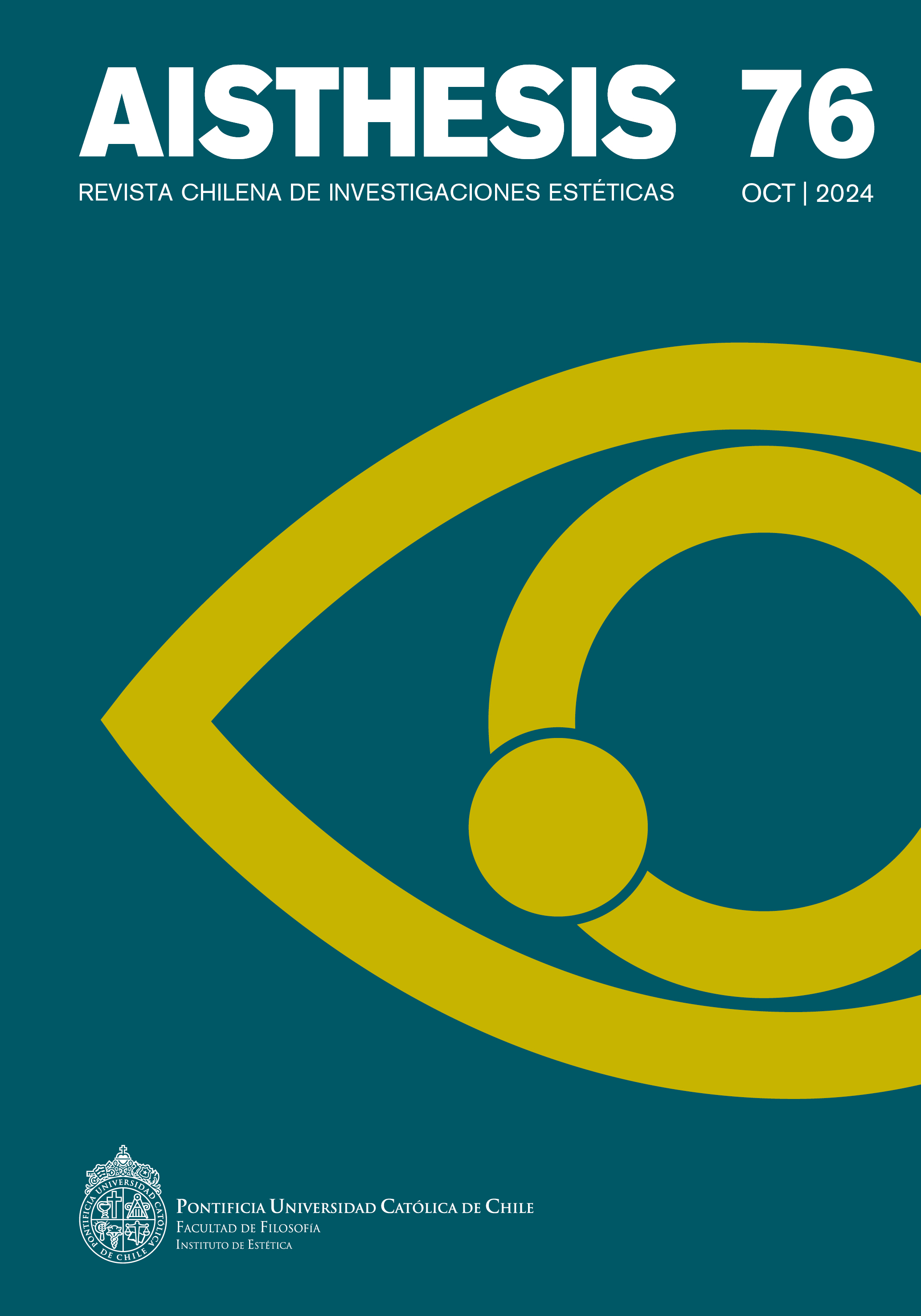Allegory and Porosity in Walter Benjamin. From Trauerspiel to the Essay on Naples
Main Article Content
Abstract
On August 19, 1925, Walter Benjamin and Asja Lacis published Naples in Frankfurter Zeitung. It is an essay about the Italian city, where they analyze the customs and cultural practices of the area through a peculiar method of image superimposition. It is common to interpret One-Way Street as the work in which Benjamin first approaches physiognomy as a form of expression. This paper aims to address the first of the city physiognomies that Benjamin wrote in the 1920s. The objective is to show how Benjamin sets in motion, in these city portraits, a theory of representation based on the study of allegory in The Origin of German Tragic Drama. The essay on Naples will be presented as the first of the exercises undertaken by Benjamin to apply his research on Baroque drama to problems of contemporary culture.
Downloads
Article Details

This work is licensed under a Creative Commons Attribution-NonCommercial-ShareAlike 4.0 International License.
All contents of this electronic edition are distributed under the Creative Commons license of "Attribución-shareAlike 4.0 Internacional" (CC-BY-SA). Any total or partial reproduction of the material must mention its origin.
The rights of academic works published in this publication belong to their authors., who grant to AISTHESIS: Revista Chilena de Investigaciones Estéticas the license for its use. The management of the permits and the authorization of the publication of the images (or of any material) that contains copyright and its consequent rights of reproduction in this publication is the sole responsibility of the authors of the articles
References
Referencias
Adorno, Theodor W. Noten zur Literatur. Gesammelte Schriften 11. Suhrkamp, 1974.
––. «Seminar von Sommersemester 1932 über Benjamins Ursprungs des deutschen Trauerspiels», Frankfurter Adorno Blätter, IV, text + kritik, 1992.
Amin, Ash y Thrift, Nigel. Cities. Reimagining the Urban. Polity, 2002.
Battafarano, Italo, ed. Italienische Reise, Reisen nach Italien. Reverdito, 1988.
Benjamin, Walter. Das Passagen-Werk. Gesammelte Schriften V. Suhrkamp, 1972.
––. Einbahnstrasse. Gesammelte Schriften IV.1. Suhrkamp, 1972.
––. Gesammelte Briefe II. Suhrkamp, 1998.
––. Gesammelte Briefe III. Suhrkamp, 1980.
––. Kritiken und Rezensionen, Gesammelte Schriften III. 1972.
––. Moscow. Gesammelte Schriften IV.1. Suhrkamp, 1972.
––. Neapel, Gesammelte Schriften IV.1. Suhrkamp, 1972.
––. Programm eines proletarischen Kindertheaters, Gesammelte Schriften II.2. Suhrkamp, 1977.
––. Rundfunkgeschichten für Kinder, Gesammelte Schriften VII.1. 1991.
––. Ursprung des deutschen Trauerspiels, Gesammelte Schriften I.1. Suhrkamp, 1978.
Blätter, Christine y Christian Voller, eds. Walter Benjamin. Politisches Denken. Nomos, 2016.
Bub, Stefan. «Porosität und Gassengeschlinge. Siegfried Kracauers und Walter Benjamins mediterrane Städtebilder». KulturPoetik, vol. 10, nº 1, 2010, pp. 48-61.
Buck-Morss, Susan. Dialéctica de la mirada. Walter Benjamin y el proyecto de los Pasajes. La balsa de la medusa, 1995.
Cacciari, Massimo. Architecture and Nihilism. On the Philosophy of modern architecture. Yale University Press, 1993.
Casini, Eugenia. «The Percepciones of Asja Lacis in Italy: Impact on Theatre, Education, and Politics». Culture Crossroads, vol. 8, 2015.
Eiland, Howard. y Jennings, Michael W. Walter Benjamin. A Critical Life. The Belknap Press of Harvard University Press, 2014.
Escuela Cruz, Chaxiraxi. «La filosofía de lo roto y los rincones sombríos de la modernidad», en: Sohn-Rethel, Alfred. El ideal de lo roto y otros textos. Dado, 2024
Fellman, Benjamin. Durchdringung und Porosität. Walter Benjamins Neapel. LIT-Verlag, 2014.
Gilloch, Graeme. Myth and Metropolis. Walter Benjamin and the City. Polity Press, 1996.
Glynn, Ruth. «Porosity and its Discontents. Approaching Naples in Critical Theory». Cultural Critique, vol. 107, 2020, pp. 63-98.
Hallelstein, Ulla, ed. Allegorie: DFG-Symposion 2014. De Gruyter, 2016.
Jennings, Michael. «Trugbild der Stabilität. Weimarer Politik und Montage Theorie in Benjamins Einbahnstraße», Global Benjamin. Internationaler Walter-Benjamin-Kongress 1992, editado por G. Klaus. Fink, 1999, pp. 517-528.
Kaulen, Heinrich. «Walter Benjamin und Asja Lacis. Eine biographische Konstellation und ihre Folgen». Deutsche Vierteljahrsschrift für Literaturwissenschaft und Geistesgeschichte, vol. 69, nº 1, 1995, pp. 92-122.
Kerik, Claudia. «Walter Benjamin y la ciudad. Magia y melancolía». Gaceta del Fondo de Cultura Económica, vol. 243, 1991, pp. 31-35.
Kohan, Martin. Zona urbana. Ensayo de lectura sobre Walter Benjamin. Trotta, 2007.
Köhnen, Ralph, ed. Denkbilder. Wandlungen literarischen und ästhetischen Sprechens in der Moderne. Peter Lang, 1996.
Kracauer, Sigfried. Das Ornament der Masse. Essays. Suhrkamp, 1963.
Lacis, Asja. Revolutionär im Beruf. Berichte über Proletar, Theater, über Meyerhold, Brecht, Benjamin und Piscator. Rogner & Bernhard, 1976.
Lindner, Burkhardt. «Allegorie», Benjamins Begriffe, editado por M. Opitz y E. Wizisla. Suhrkamp, 2000.
Mele, Vicenzo. Metropolis. Georg Simmel, Walter Benjamin e la modernità. Belforte Edizioni, 2011.
Menke, Bettine. «Bild-Textualität. Benjamins schriftliche Bilder». Der Entzug der Bilder. Visuelle Realitäten, editado por M. Wetzel y H. Wolf. Fink, 1994.
Mittelmeier, Martin. «Asja Lacis in Neapel. Wie das Konzept der Porosität den Stil der Texte Walter Benjamins und Theodor W. Adornos beeinflusst». Kulturgeschichte Krustpunkti, vol. 8, 2015, pp. 79-85.
Moe, Nelson. The View from Vesuvius: Italian Culture and the Southern Question. University of California Press, 2002.
Mota, Alexandra Virginia. «Uma voz a quatro mãos: Walter Benjamin y Asja Lacis». Artefilosofia. Revista do Programa de Pós-graduação em filosofia da UFCP, vol. 15, nº 29, 2020, pp. 135-150.
Müller Farguell, Roger. «Städtebilder, Reisebilder, Denkbilder», Benjamin-Handbuch. Leben - Werk - Wirkung, editado por B. Lindner. Metzler, 2011.
Naeher, Jürgen. Walter Benjamins Allegorie-Begriff als Modell. Zur Konstitution philosophischer Literaturwissenschaft. Klett-Cotta, 1977.
Paškevica, Beata. In der Stadt der Parolen. Asja Lacis, Walter Benjamin und Bertolt Brecht. Klartext, 2006.
Reijen, Willem, ed. Allegorie und Melancholie. Suhrkamp, 1992.
Schlaffer, Heinz. «Denkbilder. Eine kleine Prosaform zwischen Dichtung und Gesellschaftstheorie». Poesie und Politik. Zur Situation der Literatur in Deutschland, editado por W. Kuttenkeuler. Kohlhammer, 1973.
Schweppenhäuser, Hermann. «Para una fisionomía de un fisionomista». Constelaciones. Revista de Teoría Crítica, vol. 2, nº 2, pp. 14-37
Sohn-Rethel, Alfred. El ideal de lo roto y otros textos. Dado, 2024
Szondi, Peter. «Benjamins Städtebilder». Schriften 2. Suhrkamp, 1978.
Ujma, Christina. «Zweierlei Porosität, Walter Benjamin und Ernst Bloch beschreiben italienische Städte». Rivista di letteratura e cultura tedesca, 2008, pp. 57-64.
